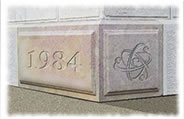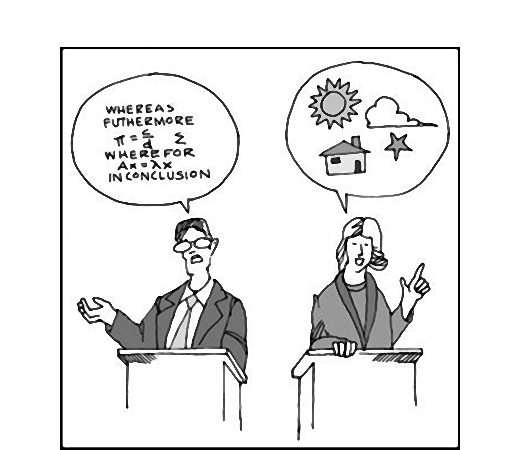Speech or Presentation…
A tale of two minds
“We all have the same tools, but some people seem to use them better.”
— J. E. Morrow
Let’s focus on the two different mindsets that you might employ to solve two different communication assignments: the Speech and the Presentation.
“What’s the big deal?” you say, “Speech, Presentation — what’s the difference? It’s just semantics.”
Well, No — actually — they’re not the same. They are siblings. Though they share the same roots, they occupy opposite wings of the House of Communication. While speeches and presentations are radically different, unfortunately many people facing a presentation, reflexively reach for their speechwriting tools.
(Cautionary statement: Communication — and Life — aren’t always an either/or choice. You might often face a “blur moment,” where you’ll draw on both sets of skills and create a prize-winning hybrid. But today, let’s get clear about the differences.)
SPEECH
SPEECHES are SPOKEN LITERATURE — TEXT: They are Formal, scripted — given to high flown rhetoric and phrasemaking for big audiences. They’re Rooted in Oratory and Oxford style debating. Speeches are written… Composed.
People rehearse heavily, memorize, and may require teleprompters. Speakers tend to stay in place. No room for mistakes or slip ups.
Speeches are designed to be reprinted, quoted and ultimately aim to be republished now and forever — hence the careful attention to Wordsmithing and turning out quotable phrases and sound bites. Press Corps, hold your questions until the end… (I can’t remember the last time the press attended one of my presentations… or was invited.)
Speeches inform, entertain or lay a political foundation. Speeches are solid — unchanging. A speech is meant to incite and inspire. It has its eye on history. It’s more public. It’s a form of self-expression for a unique point of view. We want to know what this person thinks! We may decide to elect them, or elevate them to a post.
PRESENTATION
PRESENTATIONS are THINKING OUT LOUD. More private, smaller audiences. No fee. They are often unscripted. There probably won’t be an anxious press corps asking for the transcript. They employ visual aids, props and demonstrations. The speaker has more latitude for movement around the room, to stand or sit as desired, to entertain questions, to ask the audience questions — to engender live discussions and interplay.
Presentations are constructed, not composed. They usually have a business purpose — focus on a business outcome — a tangible result or next step. Rehearsal is part of the package, yet often they happen at the drop of a hat, tend to be more extemporaneous or even impromptu, and are not usually recorded or filed.
And, they fade away as the listeners leave the room. (Should you address being memorable and repeatable? Only if you want to be memorable or repeatable as you think out loud.) Presentations are practical and often have limited shelf-life. Presenters are not running for office, though they might be angling for a promotion.
Though these two siblings often borrow from each other, their differences are the reason we generally employ different methods, minds and tools for their creation.
TEXT VS. BULLETS
Speeches are Written and take the form of text on a page. Presentations on the other hand are Constructed and take the form of bullet points in boxes — to allow the speaker to improvise in the moment and flow with the audience’s questions and concerns. Speeches rely on the Wordsmith’s tools to write, edit, smooth and nuance the content to obtain the desired public effect and response. Speechwriting tends to be linear — laborious, sometimes rigid, as the writer strings together words, punctuation, sentences and paragraphs to make a coherent — perhaps beautiful — result.
Presentations are, or should be, without “scripts.” They have notes, plans, formats, flow charts, diagrams. Presentations are fluid. And because they are not completely linear, can avail themselves of our more creative, intuitive, holographic ways of thinking. A presentation is a point of departure for improvisation as you “play off the audience.” Think bullets instead of paragraphs. Notes/bullets mean freedom. This freedom is employed in the “Ready, Set, Go!®” boxes. You can deliver a little differently next time as the audience and the situation require. You are extemporizing, not reading — so you have freedom to look at your audience and really connect. Reading a script well is tough enough to defeat Presidents — don’t saddle yourself with a script for a presentation!
USE THE RIGHT TOOL FOR PRESENTATIONS
You wouldn’t use a screwdriver to cut wood. (Though, some of us might…)
The right tool is everything; yet many persist in clinging to their familiar, linear mindset and tools — text, sentences, paragraphs and writing to move forward word by word… often asking for software that makes the words smaller in the boxes. In effect — reaching for the familiar “screwdriver” — when what’s really needed is to let go and free the intuitive, compositional mind to think about the big picture and the bullet points. Use the right tool for the job. We don’t care which side of the brain you use, but chuck the speech tools and let your extemporaneous genius fly.
“Ready, Set, Go!” is a tool for rapid composition — not for speeches as literature — but for powerful extemporaneous presentations. (True, it’s not a bad first step for a speech, either.)
Step away from the text — and embrace the boxes!
Applications
1. Personally
Embrace the idea that constructing/composing a presentation is an exercise in creating and juxtaposing ideas, not sentences. The use of bullet points frees you from tight script-writing and allows you to get focused on what ideas, in which order, will get the desired result. Set aside time to practice, and get into the habit of sketching out a box diagram before a meeting, a phone call or an email. You’ll be surprised how much you can accomplish and how effective you become when you let go of linear text.
2. At Home
Two challenges: getting the time, and using it well. Is an appointment required to have a conversation with your spouse? Is it difficult to find five uninterrupted minutes with the kids? Do the electronic “aids” actually hinder the intimacy of watching TV together — is everyone watching the same screen? Time for some strategy! Why not bow to the fact that the outside world makes increasing claims on our time… Make communication with the family that much clearer, concise and hence, valuable and special? Strategize about the things you need to discuss and, rather than writing a “speech” or simply “letting fly,” chunk your ideas into concise, boxed arguments. Now instead of giving in to the urge to vent, stake out ten uninterrupted minutes to discuss the vacation, the kids’ school or your investments.
3. At Work
Wait a minute: Is this the same challenge writ large? In a world where everything happens at once, the power of someone who knows how to get the most out of ten minutes is undeniable. Short meetings, in small crunchy bites make the best use of everyone’s fragmented attention spans.
When building a Speech, begin with the boxes to pare away the excess, then get down to it with a keyboard or pen and paper. Building a Presentation? Work the boxes and let the words “appear” in rehearsal!
The better you know your tools the better you can use them!
Subscribe to our Newsletter


